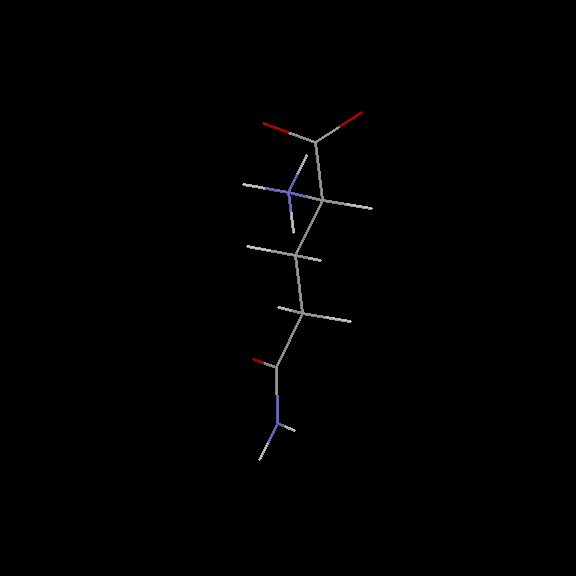L-glutamine
Glutamine, known by the IUPAC-IUBMB abbreviations Gln and Q, represents an α-amino acid, with its L enantiomer being one of the 22 proteinogenic amino acids, encoded by messenger RNAs utilizing the CAA and CAG codons. It results from the amidation of the terminal carboxyl of glutamic acid. It yields electrically neutral polar residues that tend to form hydrogen bonds due to its amide group. Its van der Waals radius measures 114 Å.
Glutamine plays a crucial role in various biological processes. As a semi-essential amino acid, it is particularly important in the metabolism of rapidly dividing cells, such as immune and intestinal cells. Additionally, it is used as an energy source for enterocytes and is critical for maintaining the integrity of the intestinal mucosa.
In addition to its role in cellular metabolism, glutamine is involved in regulating the acid-base balance, acting as a buffer in the kidneys. It also plays a key role in the transport of nitrogen between tissues and in the synthesis of purines and pyrimidines, essential components of DNA and RNA.
Due to its multiple biological functions, glutamine is often used as a supplement to support digestive health, the immune system, and muscle function. Studies have suggested that glutamine may help alleviate the adverse effects of certain medical therapies, such as chemotherapy, by protecting intestinal cells and promoting recovery after tissue injuries.
Accession Number : KLM0000185This work is released into the public domain; please see our release statement.

Synonyms :
- L-GLUTAMINE
- Gln
- Q
Config Rule :
config('L-glutamine',[
substituent(aminoacid_L_backbone),
substituent(ethylamide),
linkage(from(aminoacid_L_backbone,car(1)),
to(ethylamide,car(1)),
down,single)]).
%%%% Substituent Config Rules for compound 'L-glutamine' %%%%
config(aminoacid_L_backbone,[
left(amino),
right(hyd),
top(carboxyl),
center(car(1))]).
config(ethylamide,[
top(methandiyl(1,empty)),
center(methandiyl),
bottom(keto(3,amine))]).
Smiles String :
[C@2H]([NH3+])([C](=[O])[O-])[C@2H2][C@2H2][C](=[O])[NH2] 'L-glutamine'
Fischer Diagram :

Terminal :
% 'L-glutamine'
c(1,12,(0,chiral))-[n(1,left)~,h(1,right)~,c(2,up)~,c(3,down)~],
c(2,12,(0,nonchiral))-[o(1,nil)?,o(2,nil)?,c(1,down)~],
c(3,12,(0,nonchiral))-[c(4,left)~,h(7,right)~,c(1,up)~,h(8,down)~],
c(4,12,(0,nonchiral))-[c(5,left)~,c(3,right)~,h(5,up)~,h(6,down)~],
c(5,12,(0,nonchiral))-[o(3,nil)~~,c(4,right)~,n(2,nil)~],
h(1,1,(0,nonchiral))-[c(1,left)~],
h(2,1,(0,nonchiral))-[n(1,right)~],
h(3,1,(0,nonchiral))-[n(1,down)~],
h(4,1,(0,nonchiral))-[n(1,up)~],
h(5,1,(0,nonchiral))-[c(4,down)~],
h(6,1,(0,nonchiral))-[c(4,up)~],
h(7,1,(0,nonchiral))-[c(3,left)~],
h(8,1,(0,nonchiral))-[c(3,up)~],
h(9,1,(0,nonchiral))-[n(2,nil)~],
h(10,1,(0,nonchiral))-[n(2,nil)~],
n(1,14,(1,nonchiral))-[h(2,left)~,c(1,right)~,h(3,up)~,h(4,down)~],
n(2,14,(0,nonchiral))-[h(9,nil)~,h(10,nil)~,c(5,nil)~],
o(1,16,(-5.0E-01,nonchiral))-[c(2,nil)?],
o(2,16,(-5.0E-01,nonchiral))-[c(2,nil)?],
o(3,16,(0,nonchiral))-[c(5,nil)~~]
The Terminals for all the Config Rules are in Prolog Definite Clause Grammar (DCG) form.They can be checked in the Manual here.
The compound's PDB file can be seen here.
